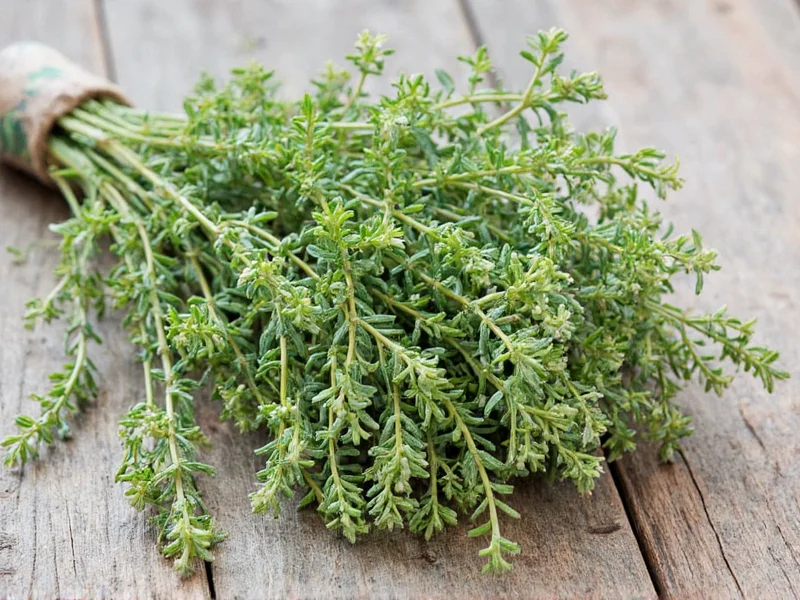Thyme isn't just a clever pun on the familiar biblical phrase—it's a gardening and culinary reality for herb enthusiasts. Unlike many annual herbs that complete their life cycle in one growing season, common thyme (Thymus vulgaris) is a perennial that reliably returns year after year in appropriate climates, making it truly a herb for all seasons. This resilience, combined with its culinary versatility and medicinal properties, explains why thyme has been cultivated for thousands of years across diverse cultures.
Why Thyme Earns Its "All Seasons" Reputation
Thyme's year-round viability stems from its botanical characteristics as a low-growing, woody perennial in the mint family (Lamiaceae). Most culinary thyme varieties are hardy to USDA zone 5, with some cultivars surviving in zone 4 with proper winter protection. In warmer climates (zones 7-10), thyme often remains evergreen throughout winter, providing fresh harvests even during colder months.
The herb's small, narrow leaves minimize water loss, while its woody stems provide structural support through seasonal changes. Thyme's natural drought tolerance and preference for well-drained soil make it particularly adaptable to various growing conditions. When established, a single thyme plant can thrive for 5-10 years with proper care, continuously producing aromatic leaves that intensify in flavor when grown in full sun with minimal water.
Seasonal Thyme Gardening Guide
Successful year-round thyme cultivation requires understanding its seasonal needs. The following table outlines essential care practices throughout the year:
| Season | Key Activities | Harvest Tips | Climate Considerations |
|---|---|---|---|
| Spring | Prune back winter-damaged growth; fertilize lightly; divide established plants | Begin harvesting once new growth reaches 4-6 inches | In colder zones, wait until after last frost; in warm climates, plant early spring |
| Summer | Water sparingly; deadhead flowers to encourage leaf production; watch for pests | Harvest morning after dew dries for peak essential oil concentration | Provide afternoon shade in extremely hot climates; ensure excellent drainage |
| Fall | Reduce watering; avoid late-season fertilizing; prepare for winter | Final major harvest before first frost for drying | In zones 5-6, apply light mulch after ground cools; in warmer zones, minimal care needed |
| Winter | Minimal intervention; protect container plants; avoid wet soil | Harvest sparingly from evergreen varieties; use preserved thyme | In cold zones, mulch after ground freezes; in mild climates, fresh harvests continue |
Culinary Applications Across the Calendar
Thyme's flavor profile—earthy, slightly floral, with hints of mint and lemon—complements seasonal ingredients throughout the year. Unlike dried thyme, which develops a more intense, concentrated flavor, fresh thyme offers brighter, more nuanced notes that vary slightly with the seasons.
In spring, pair young, tender thyme with early vegetables like asparagus, peas, and artichokes. Summer brings opportunities to use thyme with grilled vegetables, tomatoes, and fresh beans. As autumn arrives, thyme enhances root vegetables, squash, and hearty soups. During winter months, preserved thyme (dried or frozen) continues to flavor stews, roasted meats, and warming beverages.
Professional chefs often note that thyme harvested in summer contains higher concentrations of thymol (its primary essential oil), making it particularly potent for marinades and long-cooking dishes. Winter-harvested thyme, while less intense, offers a more delicate flavor perfect for finishing dishes.
Varietal Selection for Continuous Harvest
While common thyme (Thymus vulgaris) serves as the culinary standard, selecting appropriate varieties enhances year-round production:
- English Thyme - The most widely used culinary variety, hardy to zone 5, with classic flavor
- Lemon Thyme - Adds citrus notes, slightly less cold-hardy (zone 6), excellent for summer dishes
- Winter Thyme - Specifically bred for cold tolerance (zone 4), maintains flavor through winter
- Creeping Thyme - Ornamental variety that's also edible, ideal for ground cover in mild climates
- French Thyme - More delicate flavor, best for warmer climates (zone 7+)
For gardeners in colder zones seeking continuous harvest, combining multiple varieties extends the fresh thyme season. Container-growing select varieties allows moving plants indoors during extreme cold, while greenhouse cultivation enables year-round production even in northern climates.
Preservation Techniques for Year-Round Enjoyment
When fresh harvests diminish during winter months in colder climates, proper preservation ensures thyme remains available:
- Drying - Hang small bundles upside down in a dark, well-ventilated space; store in airtight containers away from light
- Freezing - Chop fresh thyme, mix with water or olive oil, and freeze in ice cube trays for convenient cooking portions
- Infused Oils - Combine fresh sprigs with high-quality olive oil for flavorful cooking base
- Vinegar Preserves - Create aromatic vinegars for salad dressings and marinades
Dried thyme retains most of its flavor compounds for 6-12 months when properly stored, while frozen thyme maintains nearly all its fresh characteristics for up to 18 months. These preservation methods transform seasonal abundance into year-round culinary resource, truly making thyme a herb for all seasons.
Common Challenges in Year-Round Thyme Cultivation
Despite its hardiness, thyme faces seasonal challenges that affect year-round production. Root rot from winter wetness represents the most common threat in colder climates, while excessive summer heat can cause woody stems to become brittle. In regions with high humidity, fungal diseases may affect plants during rainy seasons.
Successful year-round cultivation requires addressing these challenges through proper site selection (full sun, excellent drainage), appropriate watering practices (drought-tolerant once established), and strategic mulching (applied after ground cools in fall, not before). Container growing provides additional control over soil conditions and allows moving plants to optimal locations as seasons change.











 浙公网安备
33010002000092号
浙公网安备
33010002000092号 浙B2-20120091-4
浙B2-20120091-4